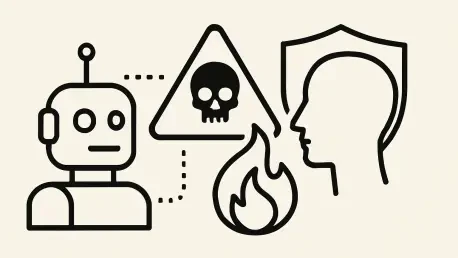The rapid evolution of AI agents has transformed technology landscapes, but with this advancement comes a staggering challenge: a vast and dynamic attack surface that leaves systems vulnerable to manipulation from diverse sources like emails, web content, and downloaded files. These agents, unlike their predecessors, don’t just generate content—they interact directly with user environments, creating unprecedented risks such as executing malicious scripts or enabling account takeovers. This pressing issue underscores the urgency of developing robust safety measures to protect users and systems alike.
The objective of this FAQ article is to address critical questions surrounding AI safety, offering clear guidance and actionable insights for building trustworthy technology. It explores a comprehensive blueprint that spans strategic design, practical testing, and industry collaboration. Readers can expect to gain a deeper understanding of the risks posed by AI agents, the steps needed to mitigate them, and the importance of standardized approaches in ensuring long-term security.
This content is designed for anyone interested in the intersection of AI and safety, from developers to policymakers, providing a structured pathway toward mitigating the inherent dangers of interactive AI systems. By delving into specific strategies and real-world applications, the article aims to equip readers with the knowledge to navigate this complex and evolving field.
Key Questions on AI Safety
What Are the Core Risks of AI Agents in User Environments?
AI agents represent a significant leap from static models, as they actively engage with user environments, accessing data and performing tasks autonomously. This interactivity, while innovative, opens up a wide range of vulnerabilities, including susceptibility to prompt injections, phishing attempts, and inadvertent data leaks. The potential for malicious actors to exploit these weaknesses—whether through a deceptive email or a harmful script—poses a substantial threat to both individual users and organizations.
Understanding these risks is crucial because the consequences can be severe, ranging from compromised personal information to full system takeovers. For instance, an AI agent handling sensitive corporate data could be tricked into revealing confidential details through a cleverly disguised interaction. Addressing this challenge requires a fundamental shift in how safety is approached, moving beyond traditional evaluations to more proactive and comprehensive measures.
How Can Safety Be Integrated into AI Design from the Start?
Building safety into AI systems from the outset is a foundational step that prevents vulnerabilities from emerging later in the development process. This approach begins with defining the agent’s use case, a detailed exercise that outlines its intended purpose, data access, and operational boundaries. For example, an agent designed for financial transactions demands stricter safeguards than one built for casual user queries, highlighting the importance of context in risk assessment.
Beyond use case definition, creating a detailed risk taxonomy is essential. This involves mapping out potential threats and user intentions, from simple misuse to complex adversarial tactics, ensuring no blind spots remain. Additionally, establishing a clear response policy acts as a guiding framework, dictating how the agent should react to risky scenarios, such as requests for illegal information or ambiguous tasks. Together, these steps transform safety from an abstract goal into a measurable and actionable standard.
What Role Does Advanced Red Teaming Play in AI Safety?
Once a strategic safety framework is established, testing it against real-world threats becomes imperative, and this is where advanced red teaming proves invaluable. Red teaming involves simulating adversarial attacks to identify weaknesses, focusing on specific risks like external prompt injections or subtle errors that could lead to data exposure. A notable case study involved an AI agent for a leading language model producer, which underwent over 1,200 test scenarios before launch to ensure robustness.
This rigorous process not only uncovers flaws but also creates reusable testing environments, akin to a security training ground for continuous improvement. By mimicking threats such as malicious ads or phishing emails, red teaming directly confronts the most pressing dangers facing AI agents. The outcome is a hardened system better equipped to handle evolving risks, ensuring that safety measures remain relevant as technology advances.
Why Is Industry-Wide Standardization Essential for AI Trust?
While individual testing efforts are critical, achieving consistent safety across the AI ecosystem demands a unified approach through industry-wide standardization. Without a common benchmark, safety levels vary widely between models, creating uncertainty and fragmented trust. This gap is addressed by initiatives like the AILuminate benchmark, supported by both industry and academic communities, which provides a transparent standard for evaluating AI safety.
AILuminate’s methodology is comprehensive, curating thousands of hazardous prompts across multiple languages and risk categories, such as misinformation and violence promotion. Each test is layered with elements like user personas and adversarial techniques, ensuring realistic and challenging assessments. This shared tool enables developers and risk managers to measure their models against a consistent standard, fostering a safer and more reliable AI landscape for all stakeholders.
How Does a Cohesive Blueprint Tie These Elements Together?
A cohesive blueprint for AI safety integrates strategic design, practical testing, and standardized evaluation into a seamless process. It starts with embedding safety principles during the initial development phase, ensuring that risks are scoped and addressed proactively. This foundation then informs red teaming efforts, which test theoretical safeguards against tangible threats, refining the system’s defenses in real-world conditions.
The final piece involves scaling these efforts through industry collaboration, ensuring that safety isn’t confined to individual projects but extends across the entire field. By connecting these stages, the blueprint transforms isolated safety practices into a unified strategy. This holistic approach is essential for defusing the inherent risks of AI agents and building technology that users can trust in any context.
Summary of Key Insights
This article addresses pivotal questions about AI safety, from identifying core risks to outlining a structured blueprint for mitigation. It emphasizes the importance of integrating safety into design through defined use cases, risk taxonomies, and response policies. Practical testing via advanced red teaming ensures that these strategies hold up under pressure, while industry standardization fosters consistency and trust across diverse systems.
The main takeaway is that a connected approach—spanning strategy, testing, and collaboration—is vital for managing the dynamic threats posed by AI agents. Readers are encouraged to explore resources like the AILuminate benchmark documentation for deeper insights into standardized safety measures. Understanding these elements equips stakeholders to contribute to a more secure AI ecosystem.
Final Thoughts
Reflecting on the journey through AI safety challenges, it becomes evident that isolated efforts, though valuable, are insufficient to address the scale of risks introduced by interactive agents. The path taken reveals a pressing need for a unified framework that can adapt to an ever-changing threat landscape. This realization underscores the importance of collective action in technology development.
Moving forward, stakeholders are urged to consider how these safety principles apply to their own projects or environments, whether in development, policy, or end-user contexts. Exploring partnerships for industry benchmarks or adopting rigorous testing protocols emerges as actionable steps to enhance trust. Embracing this blueprint offers a way to not only mitigate risks but also pave the way for innovative, secure AI solutions in the years ahead.









